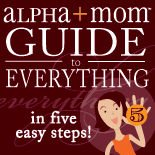
How To Navigate the Supermarket Like a Nutritionist
I was fortunate enough to get an in-depth supermarket tour with a naturopathic physician, with Keegan Sheridan who works in-house at Kashi* as their Natural Lifestyle Business Partner and helps them develop natural foods.
 There are many guides to eating healthfully out there (including at Alpha Mom), but here are five easy-to-remember tips as you make your way down the supermarket aisle.
There are many guides to eating healthfully out there (including at Alpha Mom), but here are five easy-to-remember tips as you make your way down the supermarket aisle.
1) Buy a Rainbow
When you hit the fruits and vegetables, fill your cart with a rainbow; remember ROYGBIV? Red means there’s lycopene in your produce (found in tomatoes and other red fruits & vegetables, such as red carrots, watermelons and papayas) which is an antioxidant. Orange represents the beta carotene found in many fruits and vegetables. Yellow and Green stands for lutein which is an antioxidant and decreases the risk of eye diseases. Blue, Indigo and Violet (or purple) means anthocyanin is present. Plants rich in anthocyanins are the dark berries, eggplant peel, grapes and cabbage. Anthocyanins are also antioxidants and are excellent for cognitive and brain health.
2) Know the Dirty Dozen
Sometimes organic is not available or you need to make practical budgetary decisions. That’s when you should refer to the Environmental Working Group’s “Dirty Dozen” List so that you’ll know which produce needs to be bought organic (and without pesticides), and which conventionally-grown fruits and vegetables are okay if you just can’t buy organic this time ’round. There’s a downloadable guide and even an iPhone app. But in case you don’t have the list on you, the general rule of thumb is that thin-skinned produce should be your organic choices.
3) Flash Frozen is Equal to Fresh
When produce is not in season, don’t forget the frozen aisle. Flash frozen fruits and vegetables are EQUAL to fresh produce in terms of nutrition. So bypass the canned produce and go straight to the frozen food aisle.
4) HFCS is a marker for other artificial preservatives.
High Fructose Corn Syrup (HCFS) is a highly processed sugar substitute and therefore a marker that the food has other concerning preservatives, like BHT which is artificial and sprayed into packaging. Instead nutritionists recommend looking for “mixed tocopherals” which is Vitamin E. Also, there is no reason ever to buy a product with “transfats,” which is a preservative used to extend shelf life.
5) Watch Out for Sodium
When buying frozen meals look at the sodium levels very carefully. The recommended intake per day of sodium is 2400mg or just one teaspoon, which is easy to exceed. The average person consumes two to four teaspoons per day. If you’re going to count something, track your intake of sodium.
* I participated in a blogger trip to visit Kashi HQs. They paid for my trip, including travel, lodging, activities and provided me with products. It was a blast and I continue to love their all natural foods!
Photo by Nicholas_T

